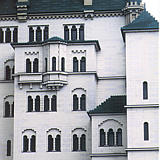
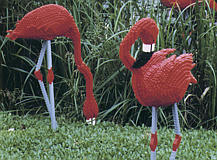
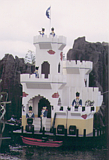
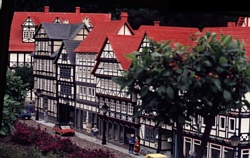
You may recall that my wife Ellen claims to have the oldest collection of Lego on the net, started in the late 1950's courtesy of annual Christmas packages from some of these same Danish relatives we were to visit. I was a relatively late starter, since my earliest Lego sets date back only to about 1963. Loren, of course, has grown up with Lego of all flavors. So all three of us were looking forward with great anticipation to seeing Legoland.
Billund has a modern airport, Denmark's second busiest, which is by itself a truly remarkable testimony to the success of Lego (since there basically isn't much in Billund aside from Lego). From this you will probably not be surprised to learn that the Legoland hotel, right next to the airport and to Legoland itself, fills up quickly. We didn't think of this, however, so it took some frantic web-searching and long-distance phoning to reserve a room in the next town (Grinsted). For those of you who may find yourself in the same position, make a note of the Jylland travel info web page http://www.dkhotellist.dk/Juts.htm Travel connections were no problem. We arrived in the afternoon and caught a bus in front of the airport which took us straight to Grinsted and let us off in front of the hotel. Well OK, it was actually across a field from the hotel... this wasn't exactly a large town. The only drawback of staying 13 km away was that we didn't make it back to start our Legoland explorations that same evening.
My heart sank the next morning when I first saw the size of the lines waiting for the 10:00 opening of the front gates. The admissions people were very efficient, however, and we spent the ten minutes or so it took to get in admiring the large lego toy soldiers above the entrance gates. When we made our way up to the front we found that the Legoland employees wore the same uniforms as the toy soldiers, complete with the Lego elephants attached at the hip where a more martial squad might holster pistols. Their buttons and epaulets were also made of Lego bricks. We checked all our luggage in a coin-locker area just by the entrance for later retrieval, since we didn't plan to return to Grinsted. We kept our cameras, of course. I shot about three rolls of slides, and Loren used up two point-and-shoot cameras.




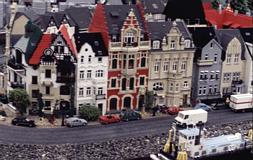 We headed straight for Miniland, where we spent most of the day.
Miniland consists of a series of landscaped gardens, or maybe you
would call them tableaux. Each is surrounded
by a sidewalk and often by a low wall or a moat. Each garden has a
theme, and is chock full of lego models connected with that theme.
By far the most of them are landscapes or cityscapes inspired by a
North European country. So there is a city-scape of Amsterdam,
a larger generic Dutch countryside, and idealized idyllic renditions
of Finland, Denmark, England, Germany, Norway, Sweden. It's difficult
to convey in words just how many lego models go into one of these
scenes. A sign by the German landscape claimed that it would take
an expert Legoland model-builder 12 years to construct the models
for that scene. Nevertheless, they claim to re-build and replace
all the models every four years. Let's see... call it a dozen
miniland scenes at 12 man-years per scene... that's a couple hundred
employees just devoted to keeping up existing models! Not to mention
all the folks who are supporting other areas or designing new models.
We headed straight for Miniland, where we spent most of the day.
Miniland consists of a series of landscaped gardens, or maybe you
would call them tableaux. Each is surrounded
by a sidewalk and often by a low wall or a moat. Each garden has a
theme, and is chock full of lego models connected with that theme.
By far the most of them are landscapes or cityscapes inspired by a
North European country. So there is a city-scape of Amsterdam,
a larger generic Dutch countryside, and idealized idyllic renditions
of Finland, Denmark, England, Germany, Norway, Sweden. It's difficult
to convey in words just how many lego models go into one of these
scenes. A sign by the German landscape claimed that it would take
an expert Legoland model-builder 12 years to construct the models
for that scene. Nevertheless, they claim to re-build and replace
all the models every four years. Let's see... call it a dozen
miniland scenes at 12 man-years per scene... that's a couple hundred
employees just devoted to keeping up existing models! Not to mention
all the folks who are supporting other areas or designing new models.
[larger JPEG image 192kB]
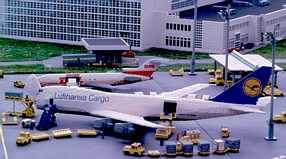 The first miniland scene one encounters is a mini Munich airport.
This scene is on a scale appropriate to minifigs, and is one of the
few places in Legoland we actually saw minifigs in use. Almost all
of the other scenes featured individually built figures about twice
the size of a minifig. As we walked up to the airport I got my first
hint of the spectacular Legoland automatation and robotics.
One of the large model planes was just taxiing down a runway.
"That's nice", I thought, "they must have a couple of the planes on
a moving track". But no. As we watched it became clear that the
animation was much more complex than that. A plane would taxi to
an airport gate, dock against a passenger tube which swung out to
meet it, wait a few minutes, taxi back out to queue up for the runway
behind other planes, and make another takeoff/landing run down the
runway before starting over again. All this with no sign of wires,
attachments, or anything visibly not made out of Lego.
The first miniland scene one encounters is a mini Munich airport.
This scene is on a scale appropriate to minifigs, and is one of the
few places in Legoland we actually saw minifigs in use. Almost all
of the other scenes featured individually built figures about twice
the size of a minifig. As we walked up to the airport I got my first
hint of the spectacular Legoland automatation and robotics.
One of the large model planes was just taxiing down a runway.
"That's nice", I thought, "they must have a couple of the planes on
a moving track". But no. As we watched it became clear that the
animation was much more complex than that. A plane would taxi to
an airport gate, dock against a passenger tube which swung out to
meet it, wait a few minutes, taxi back out to queue up for the runway
behind other planes, and make another takeoff/landing run down the
runway before starting over again. All this with no sign of wires,
attachments, or anything visibly not made out of Lego.
[larger JPEG image 336kB]
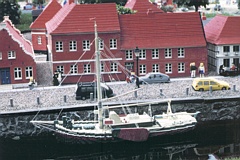 So, on to the Amsterdam cityscape. Here there were trucks and cars
running around the streets apparently on their own, barges and
tour boats navigating the canals, and marvelously idiosyncratic
figures posed against a pastiche of well-known Amsterdam canal-front
buildings. I was particularly taken by the large number of models
capturing the feel of the distinctly Dutch "schuitjes",
flat-bottomed boats with sideboards rather than a keel.
In general
there were a large number of boats in the different miniland scenes,
from small tugboats to huge frigates and modern cargo ships. They
mostly seemed to be floating, so they must have had floatation
devices inside (at least I have never had much luck at getting my Lego
boats to float on their own). I just had to know how they managed
the motion, so I peered into the water of the canals to see what
I could see. The boats which circled the canals turned out to
have a weighted bar hanging underneath to keep them upright, and were
towed by a small wire attached to a cable running around pulleys along
the bottom of the canal. In the tableaux of Norway and Germany this
mechanism sufficed even to guide moving boats through a series of
locks which functioned realistically to transfer the boats between
canals of different heights. Very simple, but clearly not the same
mechanism as was being used for the wheeled vehicles.
So, on to the Amsterdam cityscape. Here there were trucks and cars
running around the streets apparently on their own, barges and
tour boats navigating the canals, and marvelously idiosyncratic
figures posed against a pastiche of well-known Amsterdam canal-front
buildings. I was particularly taken by the large number of models
capturing the feel of the distinctly Dutch "schuitjes",
flat-bottomed boats with sideboards rather than a keel.
In general
there were a large number of boats in the different miniland scenes,
from small tugboats to huge frigates and modern cargo ships. They
mostly seemed to be floating, so they must have had floatation
devices inside (at least I have never had much luck at getting my Lego
boats to float on their own). I just had to know how they managed
the motion, so I peered into the water of the canals to see what
I could see. The boats which circled the canals turned out to
have a weighted bar hanging underneath to keep them upright, and were
towed by a small wire attached to a cable running around pulleys along
the bottom of the canal. In the tableaux of Norway and Germany this
mechanism sufficed even to guide moving boats through a series of
locks which functioned realistically to transfer the boats between
canals of different heights. Very simple, but clearly not the same
mechanism as was being used for the wheeled vehicles.
We later found an exhibit inside the small museum and play center which showed a cut-away Miniland model and explained the automation. Each mobile vehicle contains a microprocessor that controls a small electric motor driving the wheels and steering. Underneath the roads of the Miniland tableaux are guide antennae which the microprocessor can sense and use for positional feedback to drive the steering. The vehicle is powered by a rechargeable battery. When the battery gets low, the vehicle docks itself against a recharging station and stays there to top off its charge! I regret having to report that this system of robotics is not available as a commercial Lego product. It has nothing to do with the Dacta line of computer-interfaced Lego modules. If something goes wrong the system can trigger a call for help which gets transmitted as a voice message to pagers carried by the Legoland staff - "Beep - Please check train in lower Germany". Amazingly little seems to go wrong, though. We did see one of the airplanes almost blow over in a strong gust of wind, but other than that the only problems were with de-railed train cars.
I called the individual miniland scenes "gardens" because in fact they are quite verdant with grass and small shrubs. I have no idea how they keep the grass trimmed, but the museum exhibits made note of the large staff kept busy keeping the shrubs trimmed to appropriate scale heights so that they serve as miniland trees. Some flowers were real also (the smallest roses I have ever seen), but many were constructed of Lego. Ivy-covered walls at first puzzled me, but Ellen pointed out that the ivy was actually made from the little plastic bits from which Lego is molded.
[larger JPEG image 168kB]
 The buildings making up the tableaux are individually inspiring,
and the overall impression left by dozens of them in a single
scene is just awesome. It's frustrating that the oh-so-clever
details use quantities of specialized pieces that we mere mortals
could never accumulate. Thousands of tan goblet pieces to make the
balcony railings of a Swiss chalet, hundreds of brown 2x2 circles
stacked to make the masts of a frigate, hundreds of unpainted
minifig heads stacked up as cheeses in a Copenhagen market (well
OK, I guess I could manage to scrub down some minifig heads).
Still, it's mostly a question of the size of construction, not
access to nonstandard colors and oodles of specialized pieces.
The scales they are using permit an impressive level of detail
(statuary, friezes, ornate brick patterns, balustrades) to be
constructed from ordinary Lego bricks.
The buildings making up the tableaux are individually inspiring,
and the overall impression left by dozens of them in a single
scene is just awesome. It's frustrating that the oh-so-clever
details use quantities of specialized pieces that we mere mortals
could never accumulate. Thousands of tan goblet pieces to make the
balcony railings of a Swiss chalet, hundreds of brown 2x2 circles
stacked to make the masts of a frigate, hundreds of unpainted
minifig heads stacked up as cheeses in a Copenhagen market (well
OK, I guess I could manage to scrub down some minifig heads).
Still, it's mostly a question of the size of construction, not
access to nonstandard colors and oodles of specialized pieces.
The scales they are using permit an impressive level of detail
(statuary, friezes, ornate brick patterns, balustrades) to be
constructed from ordinary Lego bricks.
[larger JPEG image 256kB]
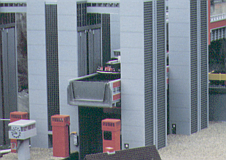 The Scandinavian tableaux were mostly historic (verging on
quaint). By contrast the German scene was quite modern and industrial,
containing oil refineries, autobahns, and a model of some high-tech
ship elevator and lock system which I would love to see the original
of. There were even model ruins, suitably representing the current
state of disrepair of several historic castles.
The Scandinavian tableaux were mostly historic (verging on
quaint). By contrast the German scene was quite modern and industrial,
containing oil refineries, autobahns, and a model of some high-tech
ship elevator and lock system which I would love to see the original
of. There were even model ruins, suitably representing the current
state of disrepair of several historic castles.
 We eventually managed to tear ourselves away from miniland, and
headed over to the Lego Safari. This consists of a single garden,
much larger than those in Miniland, which can be viewed either
from the surrounding sidewalk or from small electric carts
running on a track. We didn't take a cart or any of the other
rides - I figure I don't have to go all the way to Denmark to
ride a glorified golf cart, and I am not much enamored of
Disneyland-style rides anyway. The Safari garden contains near
life-size Lego models of animals - lions, elephants, buzzards,
etc. Our favorite by far was a cluster of flamingos by the
edge of a pond. I've never wanted a lawn flamingo, but now that
I've seen Lego ones..... Anyway, it was impressive but other
than the flamingos not nearly as inspirational as miniland.
Can you imagine sitting down to build an 8 foot high elephant,
even if someone provided all the gray bricks needed??
We eventually managed to tear ourselves away from miniland, and
headed over to the Lego Safari. This consists of a single garden,
much larger than those in Miniland, which can be viewed either
from the surrounding sidewalk or from small electric carts
running on a track. We didn't take a cart or any of the other
rides - I figure I don't have to go all the way to Denmark to
ride a glorified golf cart, and I am not much enamored of
Disneyland-style rides anyway. The Safari garden contains near
life-size Lego models of animals - lions, elephants, buzzards,
etc. Our favorite by far was a cluster of flamingos by the
edge of a pond. I've never wanted a lawn flamingo, but now that
I've seen Lego ones..... Anyway, it was impressive but other
than the flamingos not nearly as inspirational as miniland.
Can you imagine sitting down to build an 8 foot high elephant,
even if someone provided all the gray bricks needed??
[larger JPEG image 44kB]
 Pirateland is strange. Where Miniland features actual buildings
and vehicles scaled down to Lego sizes, Pirateland features current
Lego sets (the pirate line of course) scaled up to life size.
Life-size, but not very life-like, if you see what I mean. The
Lego Safari animals were lifelike enough to be taken for real
if you sort of squint. But the Pirateland figures look as if
they were made from giant Lego blocks.
Some objects like the Black Seas Barracuda dining area are just,
well, objects - wood and plaster and such. Others, like the
Imperial fort, are scaled-up versions of actual Lego sets but
still made out of Lego. So you have a 6 foot high Imperial guard
made out of I don't know how many thousand bricks, but looking
just like a giant minifig rather than like a person. As I say,
it's strange. Scattered around the area were some nice
life-size birds - mostly parrots of course. Not quite up to the
realistic standards of the Lego Safari, but more interesting to
me than giant pirate minifigs.
Pirateland is strange. Where Miniland features actual buildings
and vehicles scaled down to Lego sizes, Pirateland features current
Lego sets (the pirate line of course) scaled up to life size.
Life-size, but not very life-like, if you see what I mean. The
Lego Safari animals were lifelike enough to be taken for real
if you sort of squint. But the Pirateland figures look as if
they were made from giant Lego blocks.
Some objects like the Black Seas Barracuda dining area are just,
well, objects - wood and plaster and such. Others, like the
Imperial fort, are scaled-up versions of actual Lego sets but
still made out of Lego. So you have a 6 foot high Imperial guard
made out of I don't know how many thousand bricks, but looking
just like a giant minifig rather than like a person. As I say,
it's strange. Scattered around the area were some nice
life-size birds - mostly parrots of course. Not quite up to the
realistic standards of the Lego Safari, but more interesting to
me than giant pirate minifigs.
Younger kids (say, under 10) seemed to be having a great time at the Lego Driving School. Sort of like bumper cars, in that the kids had some steering controls.
Indoors there were play/construction areas for Duplo, Lego, and Technic. The Duplo and Lego areas would be fun if you have a lot of time to spend, but we didn't. The bins of pieces were large, and full, but mostly the pieces were standard bricks. When Loren was younger I spent many sessions with him at the Seattle Children's Museum playing with a similarly large assortment of Duplo. Even if you have a wider assortment of pieces at home, you can try things with the huge piles of ordinary bricks that you would otherwise never have sufficient quantities for. The Technic area was more attractive, even on a limited time budget. They have a large collection of Dacta instructional kits. You can check out a particular kit at a central desk and take it back to a worktable for assembly. They provide instructions, assistance, batteries, etc. Loren wanted to try a couple of these, but the ones he was interested in were all checked out at the time. I don't recall now if the computer-controlled line of Dacta kits were also available there. I noticed a row of computer stations at the back of the room, so probably they were.
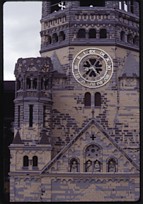 Scattered around the grounds of Legoland are individual architectural
models on a much larger scale than the tableaux in Miniland.
Many of these, but by no means all, were famous European buildings
(Danish palaces, a faithful rendition of the remains
of a German cathedral largely destroyed by bombs during the war,
the Acropolis). Some were from farther afield (a Thai temple,
one of the ancient Egyptian temples along the Nile). Those from
the USofA (the Capitol, Mount Rushmore) I didn't find very
impressive, I think largely because they were made entirely of a
single color of bricks. The more colorful buildings were much more
striking. I gather that the Legoland in Windsor specializes
instead in famous British buildings, which makes sense. I hope
that when Legoland Carlsbad opens they come up with more interesting
American scenes. Maybe a San Francisco tableau with the Golden Gate
and operating cable cars.... I just hope they stifle their penchant
for cowboys and indians.
Scattered around the grounds of Legoland are individual architectural
models on a much larger scale than the tableaux in Miniland.
Many of these, but by no means all, were famous European buildings
(Danish palaces, a faithful rendition of the remains
of a German cathedral largely destroyed by bombs during the war,
the Acropolis). Some were from farther afield (a Thai temple,
one of the ancient Egyptian temples along the Nile). Those from
the USofA (the Capitol, Mount Rushmore) I didn't find very
impressive, I think largely because they were made entirely of a
single color of bricks. The more colorful buildings were much more
striking. I gather that the Legoland in Windsor specializes
instead in famous British buildings, which makes sense. I hope
that when Legoland Carlsbad opens they come up with more interesting
American scenes. Maybe a San Francisco tableau with the Golden Gate
and operating cable cars.... I just hope they stifle their penchant
for cowboys and indians.
There is a small museum, containing exhibits relating to the history of Lego and Legoland. Not very much there really, and some of that was in Danish only. We did get to see some actual Lego injection molds. I was surprised at how small they were; the mold for 2x4 bricks only made a dozen or so at a time.
[larger JPEG image 85kB]
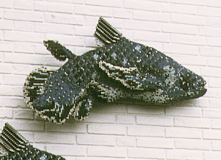 One thing I would have liked to see more of was Lego artwork.
There were a few abstract sculptures made of black Lego inside
near the cafeteria, but they were small and not very imaginative.
Much better were a set of fish sculptures on one wall near the
entrance gate.
One thing I would have liked to see more of was Lego artwork.
There were a few abstract sculptures made of black Lego inside
near the cafeteria, but they were small and not very imaginative.
Much better were a set of fish sculptures on one wall near the
entrance gate.